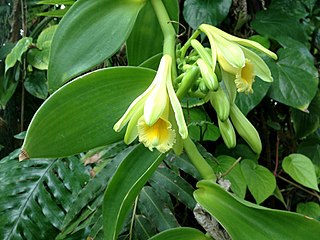
Vanilla is a spice derived from orchids of the genus Vanilla, primarily obtained from pods of the Mexican species, flat-leaved vanilla (V. planifolia). The word vanilla, derived from vainilla, the diminutive of the Spanish word vaina, is translated simply as "little pod". Pre-Columbian Mesoamerican people cultivated the vine of the vanilla orchid, called tlīlxochitl by the Aztecs.

Conifers are a group of cone-bearing seed plants, a subset of gymnosperms. Scientifically, they make up the division Pinophyta, also known as Coniferophyta or Coniferae. The division contains a single extant class, Pinopsida. All extant conifers are perennial woody plants with secondary growth. The great majority are trees, though a few are shrubs. Examples include cedars, Douglas-firs, cypresses, firs, junipers, kauri, larches, pines, hemlocks, redwoods, spruces, and yews. As of 1998, the division Pinophyta was estimated to contain eight families, 68 genera, and 629 living species.

The avocado, a tree likely originating from south-central Mexico, is classified as a member of the flowering plant family Lauraceae. The fruit of the plant, also called an avocado, is botanically a large berry containing a single large seed. Avocado trees are partially self-pollinating, and are often propagated through grafting to maintain predictable fruit quality and quantity.

Osteospermum, is a genus of flowering plants belonging to the Calenduleae, one of the smaller tribes of the sunflower/daisy family Asteraceae. They are known as the daisybushes or African daisies.

Helianthus is a genus comprising about 70 species of annual and perennial flowering plants in the daisy family Asteraceae. Except for three South American species, the species of Helianthus are native to North America and Central America. The common names "sunflower" and "common sunflower" typically refer to the popular annual species Helianthus annuus, whose round flower heads in combination with the ligules look like the sun. This and other species, notably Jerusalem artichoke, are cultivated in temperate regions and some tropical regions as food crops for humans, cattle, and poultry, and as ornamental plants. The species H. annuus typically grows during the summer and into early fall, with the peak growth season being mid-summer.

Malus domestica is a cultivar of apple that is usually eaten cooked due to its sourness. The variety comes from a pip planted by Mary Ann Brailsford. The Concise Household Encyclopedia states, "Some people eat this apple raw in order to cleanse the palate, but Bramley's seedling is essentially the fruit for tart, pie, or dumpling." Once cooked, however, it has a lighter flavour. A peculiarity of the variety is that when cooked it becomes golden and fluffy. Vitamin C 15mg/100g.

Taxodium distichum is a deciduous conifer in the family Cupressaceae. It is native to the southeastern United States. Hardy and tough, this tree adapts to a wide range of soil types, whether wet, salty, dry, or swampy. It is noted for the russet-red fall color of its lacy needles.

A seedling is a young sporophyte developing out of a plant embryo from a seed. Seedling development starts with germination of the seed. A typical young seedling consists of three main parts: the radicle, the hypocotyl, and the cotyledons. The two classes of flowering plants (angiosperms) are distinguished by their numbers of seed leaves: monocotyledons (monocots) have one blade-shaped cotyledon, whereas dicotyledons (dicots) possess two round cotyledons. Gymnosperms are more varied. For example, pine seedlings have up to eight cotyledons. The seedlings of some flowering plants have no cotyledons at all. These are said to be acotyledons.
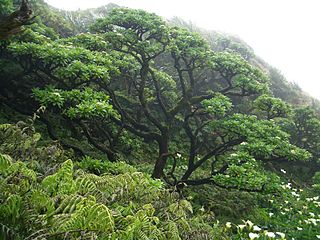
The Saint Helena scrub and woodlands ecoregion covers the volcanic island of Saint Helena in the South Atlantic Ocean. The island's remote location gave rise to many endemic species. First discovered and settled in the 1500s, the island has been degraded by human activities. Most of its native habitat has been destroyed, and many of its unique plants and animals are extinct or endangered.

Asimina triloba, the American papaw, pawpaw, paw paw, or paw-paw, among many regional names, is a small deciduous tree native to the eastern United States and Canada, producing a large, yellowish-green to brown fruit. It belongs to the genus Asimina in the same plant family as the custard-apple, cherimoya, sweetsop, ylang-ylang, and soursop.

The orange is the fruit of various citrus species in the family Rutaceae ; it primarily refers to Citrus × sinensis, which is also called sweet orange, to distinguish it from the related Citrus × aurantium, referred to as bitter orange. The sweet orange reproduces asexually ; varieties of sweet orange arise through mutations.

Banksia aemula, commonly known as the wallum banksia, is a shrub of the family Proteaceae. Found from Bundaberg south to Sydney on the Australian east coast, it is encountered as a shrub or a tree to 8 m (26 ft) in coastal heath on deep sandy soil, known as Wallum. It has wrinkled orange bark and shiny green serrated leaves, with green-yellow flower spikes, known as inflorescences, appearing in autumn. The flower spikes turn grey as they age and large grey follicles appear. Banksia aemula resprouts from its woody base, known as a lignotuber, after bushfires.
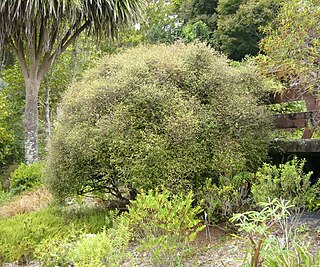
Muehlenbeckia astonii or shrubby tororaro is an endemic New Zealand shrub in the family Polygonaceae. It has distinctive small heart-shaped deciduous leaves amidst a tangle of wiry interlocking branches. Although common in cultivation around the world, it is extremely rare and threatened in the wild.

Melanodendron integrifolium is one of the endemic trees in the family Asteraceae from the island of Saint Helena. It is related to the Saint Helenan gumwoods and is the commonest of the remaining cabbage tree species of Saint Helena, although it is considered endangered due to the restricted population size.

The flora of Saint Helena, an isolated island in the South Atlantic Ocean, is exceptional in its high level of endemism and the severe threats facing the survival of the flora. In phytogeography, it is in the phytochorion St. Helena and Ascension Region of the African Subkingdom, in the Paleotropical Kingdom.
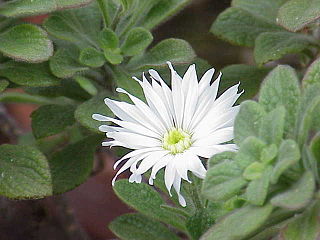
Commidendrum is a genus of trees and shrubs in the sunflower family endemic to the island of Saint Helena in the South Atlantic Ocean. The vernacular name is gumwood or scrubwood.

Commidendrum robustum, the Saint Helena gumwood, is a species of tree endemic to Saint Helena, Ascension and Tristan da Cunha. Though it is now comparatively rare, it was once one of the most abundant trees of mid-elevations of the island of Saint Helena in the South Atlantic Ocean. A small tree to 7–8 m, it was cut extensively for fuel in the early years of settlement of the island by the English East India Company. It has given its name to certain placenames on the island such as "Gumwoods". It is one of several species in the endemic genus Commidendrum.
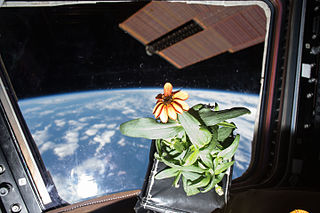
The growth of plants in outer space has elicited much scientific interest. In the late 20th and early 21st century, plants were often taken into space in low Earth orbit to be grown in a weightless but pressurized controlled environment, sometimes called space gardens. In the context of human spaceflight, they can be consumed as food and/or provide a refreshing atmosphere. Plants can metabolize carbon dioxide in the air to produce valuable oxygen, and can help control cabin humidity. Growing plants in space may provide a psychological benefit to human spaceflight crews. Usually the plants were part of studies or technical development to further develop space gardens or conduct science experiments. To date plants taken into space have had mostly scientific interest, with only limited contributions to the functionality of the spacecraft, however the Apollo Moon tree project was more or less forestry inspired mission and the trees part of a country's bicentennial celebration.
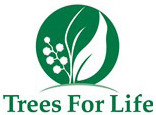
Trees For Life is a registered charity that protects and restores land in the bush, farms, and urban areas of South Australia. It runs many programs, the oldest involving volunteers growing seeds into small plants for planting by farmers and other landholders. It was formed in 1981 and now has 2000 volunteers.



















